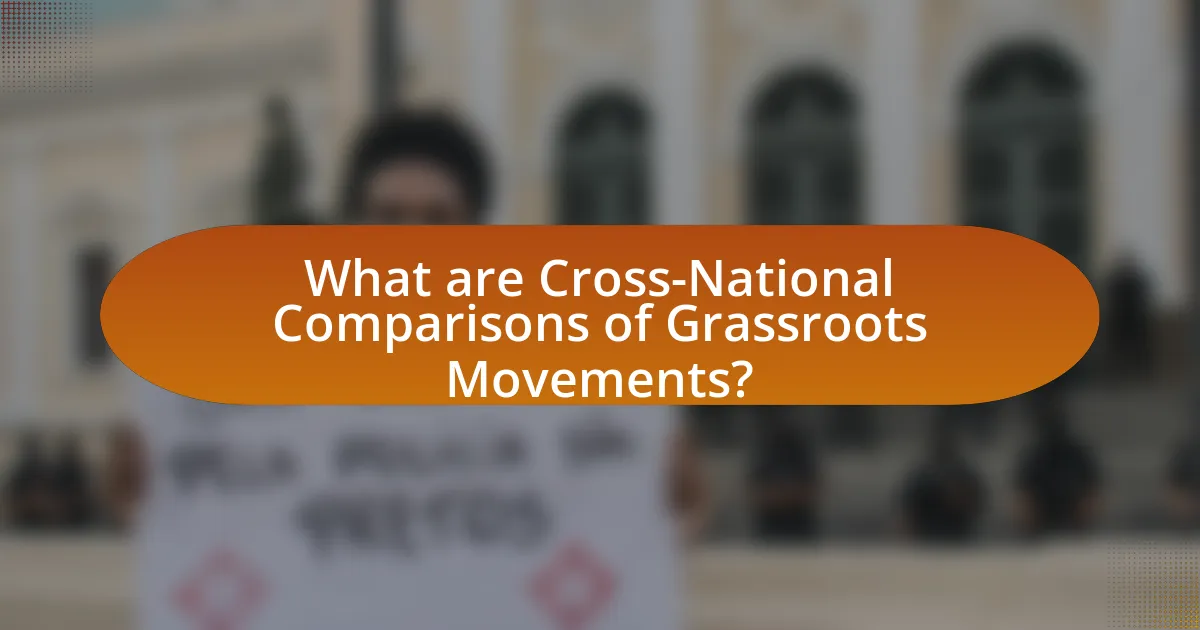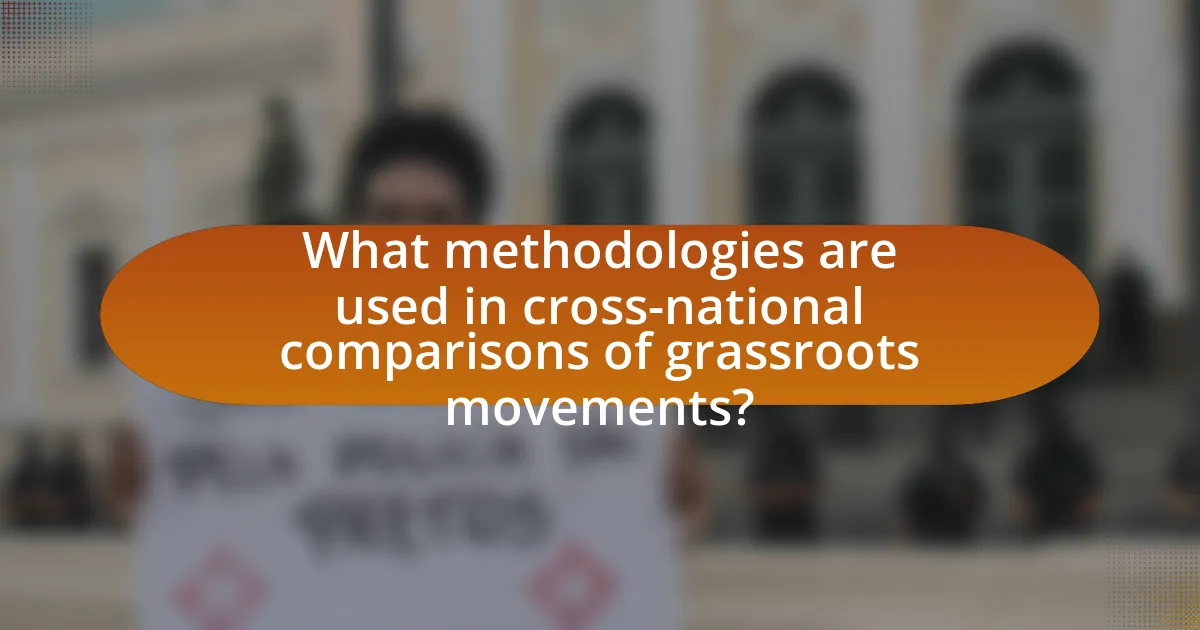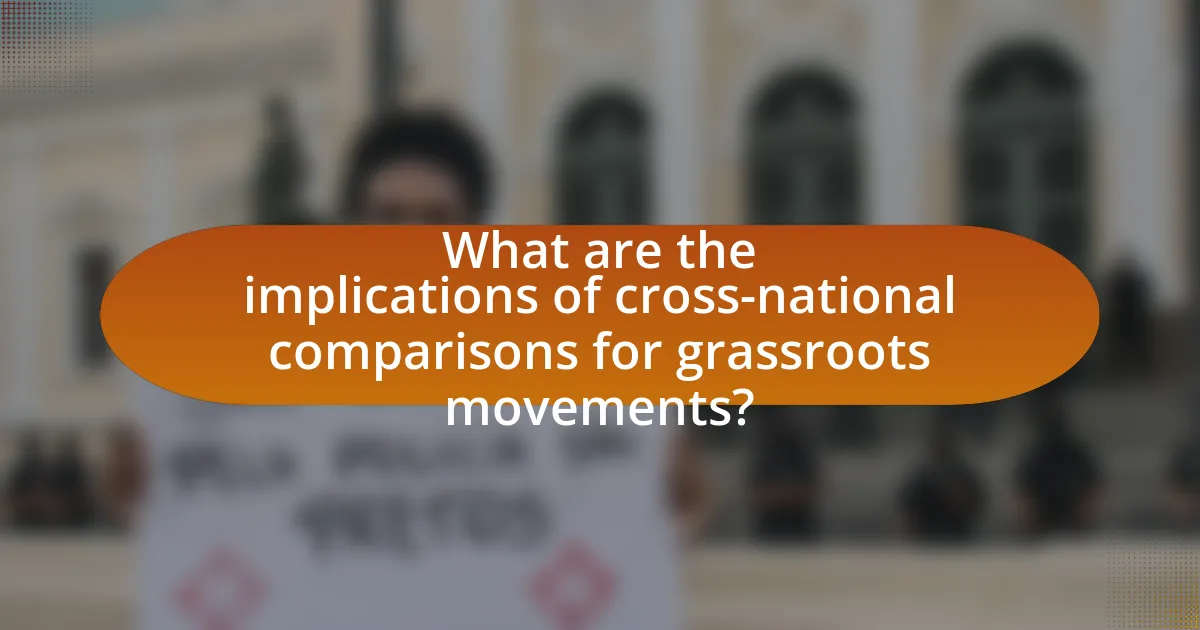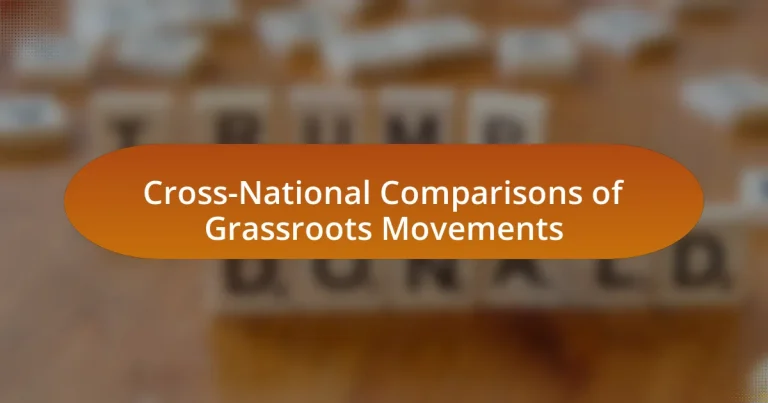Cross-national comparisons of grassroots movements involve the analysis of grassroots initiatives across various countries, focusing on their characteristics, strategies, and impacts. This article examines how local contexts, cultural factors, and political environments influence the formation and effectiveness of these movements, highlighting differences in organizational structures and goals. It discusses the factors that shape grassroots activism, including socio-political contexts, economic conditions, and cultural influences, while emphasizing the importance of cross-national comparisons for understanding global patterns of social mobilization. Additionally, the article explores methodologies for data collection, the challenges faced in gathering information, and the implications of these comparisons for policy-making and social change.

What are Cross-National Comparisons of Grassroots Movements?
Cross-national comparisons of grassroots movements involve analyzing and contrasting the characteristics, strategies, and impacts of grassroots initiatives across different countries. These comparisons reveal how local contexts, cultural factors, and political environments shape the formation and effectiveness of grassroots movements. For instance, research by Tilly and Tarrow in “Contentious performances” highlights that grassroots movements in democratic societies often utilize different tactics compared to those in authoritarian regimes, demonstrating the influence of political context on mobilization strategies. Such analyses provide valuable insights into the global patterns of social activism and the varying degrees of success achieved by grassroots movements in different national settings.
How do grassroots movements differ across countries?
Grassroots movements differ across countries primarily in their organizational structures, goals, and cultural contexts. For instance, in the United States, grassroots movements often emphasize individualism and local community engagement, as seen in movements like Black Lives Matter, which focuses on racial justice and police reform. In contrast, grassroots movements in countries like India, such as the Narmada Bachao Andolan, are often more collective and centered around environmental and social justice issues, reflecting the country’s diverse socio-economic challenges. Additionally, the political environment significantly influences these movements; for example, authoritarian regimes may suppress grassroots activism, while democratic societies may provide more space for such movements to flourish. These differences highlight how local histories, political systems, and cultural values shape the nature and effectiveness of grassroots movements globally.
What factors influence the formation of grassroots movements in different nations?
The formation of grassroots movements in different nations is influenced by socio-political context, economic conditions, cultural factors, and communication channels. Socio-political context includes the level of political repression or freedom, which can either stifle or encourage collective action; for example, countries with democratic governance often see more vibrant grassroots movements compared to authoritarian regimes. Economic conditions, such as inequality and unemployment rates, can drive individuals to mobilize for change, as evidenced by the Occupy Wall Street movement in the United States, which arose in response to economic disparities. Cultural factors, including shared identities and historical grievances, also play a crucial role; movements like Black Lives Matter in the U.S. are rooted in long-standing racial injustices. Lastly, the availability and use of communication channels, particularly social media, have transformed grassroots organizing, enabling rapid mobilization and broader outreach, as seen in the Arab Spring. These factors collectively shape the emergence and dynamics of grassroots movements across different nations.
How do cultural contexts shape grassroots activism?
Cultural contexts shape grassroots activism by influencing the values, beliefs, and practices that drive community engagement and mobilization. For instance, in collectivist cultures, grassroots movements often emphasize community solidarity and shared goals, leading to more cohesive and sustained activism. Conversely, in individualistic cultures, activism may focus on personal rights and freedoms, resulting in diverse and fragmented movements. Research by Della Porta and Diani (2006) highlights that cultural norms dictate the strategies and narratives used in activism, affecting how movements are perceived and supported by the public. Additionally, cultural contexts can determine the resources available for activism, such as funding, media coverage, and public support, which are crucial for the success of grassroots initiatives.
Why are cross-national comparisons important for understanding grassroots movements?
Cross-national comparisons are important for understanding grassroots movements because they reveal how local contexts influence the emergence, strategies, and impacts of these movements. By examining different countries, researchers can identify patterns and variations in grassroots activism, such as the role of political systems, cultural factors, and social networks. For instance, studies have shown that grassroots movements in democratic societies often utilize different tactics compared to those in authoritarian regimes, highlighting the significance of political context in shaping movement dynamics. This comparative approach enables scholars and activists to draw lessons from diverse experiences, fostering a deeper understanding of effective strategies and potential challenges faced by grassroots movements globally.
What insights can be gained from comparing grassroots movements globally?
Comparing grassroots movements globally reveals patterns of social mobilization, strategies for advocacy, and the impact of cultural contexts on activism. For instance, movements like Black Lives Matter in the United States and the anti-apartheid movement in South Africa demonstrate how local issues can resonate globally, influencing similar movements in different regions. Additionally, research indicates that grassroots movements often share common tactics, such as community organizing and digital activism, which can enhance their effectiveness across diverse political landscapes. By analyzing these movements, scholars can identify successful strategies and potential pitfalls, providing valuable lessons for future activism.
How do these comparisons impact policy-making and social change?
Cross-national comparisons of grassroots movements significantly influence policy-making and social change by providing insights into effective strategies and outcomes from different contexts. These comparisons allow policymakers to identify successful tactics employed in other nations, such as community engagement methods or advocacy techniques, which can be adapted to local circumstances. For instance, the success of the civil rights movement in the United States has inspired similar movements globally, leading to policy reforms that promote equality and justice. Furthermore, empirical studies, such as those published in the Journal of Comparative Politics, demonstrate that understanding the dynamics of grassroots movements across borders can lead to more informed and effective policy decisions, ultimately fostering social change.

What methodologies are used in cross-national comparisons of grassroots movements?
Cross-national comparisons of grassroots movements utilize methodologies such as qualitative case studies, quantitative surveys, and mixed-method approaches. Qualitative case studies allow for in-depth exploration of specific movements within different national contexts, revealing unique cultural and political factors influencing grassroots activism. Quantitative surveys enable researchers to gather data from a larger sample, facilitating statistical analysis of trends and patterns across various countries. Mixed-method approaches combine both qualitative and quantitative techniques, providing a comprehensive understanding of grassroots movements by integrating numerical data with contextual insights. These methodologies are validated by their application in studies like “The Globalization of Social Movements” by Tilly and Tarrow, which demonstrates the effectiveness of these methods in analyzing transnational activism.
How is data collected for analyzing grassroots movements across different countries?
Data for analyzing grassroots movements across different countries is collected through a combination of qualitative and quantitative methods, including surveys, interviews, social media analysis, and case studies. Surveys are often distributed to participants involved in grassroots movements to gather demographic information and insights on motivations and strategies. Interviews with activists provide in-depth perspectives on the challenges and successes faced by these movements. Social media analysis allows researchers to track engagement, sentiment, and the spread of information related to grassroots initiatives. Case studies of specific movements offer contextual understanding and highlight unique factors influencing their development. This multi-faceted approach ensures a comprehensive understanding of grassroots movements in diverse cultural and political contexts.
What are the challenges of gathering data on grassroots movements internationally?
Gathering data on grassroots movements internationally presents significant challenges due to issues such as varying definitions of grassroots activism, differing political contexts, and limited access to reliable information. The lack of a standardized framework for what constitutes a grassroots movement complicates cross-national comparisons, as movements may be labeled differently across cultures and regions. Additionally, political repression in some countries can hinder data collection efforts, as activists may operate underground or face persecution, leading to incomplete or biased data. Furthermore, language barriers and cultural differences can impede effective communication and understanding of the movements’ goals and structures. These factors collectively contribute to the difficulty in obtaining accurate and comprehensive data on grassroots movements worldwide.
Which qualitative and quantitative methods are most effective?
The most effective qualitative methods for cross-national comparisons of grassroots movements include in-depth interviews and ethnographic studies, while effective quantitative methods encompass surveys and statistical analysis. In-depth interviews provide rich, contextual insights into the motivations and experiences of grassroots activists, allowing for a nuanced understanding of their actions across different cultural contexts. Ethnographic studies enable researchers to observe movements in their natural settings, capturing the dynamics and interactions that shape grassroots efforts. On the quantitative side, surveys can gather large-scale data on participant demographics and movement impact, while statistical analysis allows for the identification of patterns and correlations across different countries. These methods collectively enhance the understanding of grassroots movements by combining detailed qualitative insights with broad quantitative trends.
What role do case studies play in understanding grassroots movements?
Case studies play a crucial role in understanding grassroots movements by providing in-depth insights into the specific contexts, strategies, and outcomes of these movements. They allow researchers to analyze the unique factors that contribute to the success or failure of grassroots initiatives, such as local culture, political environment, and community engagement. For instance, the case study of the Civil Rights Movement in the United States illustrates how grassroots organizing, community mobilization, and strategic nonviolent resistance led to significant social change. This specific example highlights the importance of localized strategies and the impact of grassroots efforts on broader societal transformations. By examining various case studies across different regions and movements, scholars can identify patterns and draw comparisons that enhance the understanding of grassroots dynamics on a global scale.
How can specific case studies illustrate broader trends in grassroots activism?
Specific case studies can illustrate broader trends in grassroots activism by providing concrete examples of strategies, outcomes, and community engagement that reflect larger patterns across different movements. For instance, the Black Lives Matter movement in the United States has inspired similar anti-racism protests globally, demonstrating how localized activism can resonate with and influence international movements. This phenomenon is evidenced by the global protests following George Floyd’s death in 2020, where activists in countries like the UK, Canada, and Australia adopted similar messaging and tactics, highlighting a shared commitment to racial justice. Such case studies reveal how grassroots movements can adapt to local contexts while simultaneously contributing to a global dialogue on social issues, thereby showcasing the interconnectedness of activism across borders.
What are some notable examples of successful grassroots movements from different countries?
Notable examples of successful grassroots movements from different countries include the Civil Rights Movement in the United States, which aimed to end racial segregation and discrimination, leading to significant legislative changes such as the Civil Rights Act of 1964. In India, the Chipko Movement successfully advocated for environmental conservation by encouraging communities to protect trees, resulting in policy changes regarding forest management. The anti-apartheid movement in South Africa mobilized grassroots support against racial oppression, culminating in the end of apartheid and the election of Nelson Mandela in 1994. Additionally, the Women’s March in the United States in 2017 galvanized millions globally to advocate for women’s rights and social justice, demonstrating the power of collective action. Each of these movements illustrates the effectiveness of grassroots organizing in achieving social and political change.

What are the implications of cross-national comparisons for grassroots movements?
Cross-national comparisons significantly influence grassroots movements by providing insights into diverse strategies, successes, and challenges faced in different contexts. These comparisons enable grassroots organizations to learn from the experiences of others, adapting effective tactics and avoiding pitfalls encountered in various political, social, and economic environments. For instance, the study “Globalization and Grassroots Movements” by Smith and Turner (2019) highlights how movements in countries like Brazil and India have successfully mobilized local communities by leveraging global networks, demonstrating the importance of contextual adaptation. Such insights can enhance the effectiveness and reach of grassroots initiatives, fostering solidarity and collaboration across borders.
How can cross-national comparisons inform activists and organizers?
Cross-national comparisons can inform activists and organizers by providing insights into successful strategies and tactics used in different contexts. By analyzing movements across various countries, activists can identify effective methods for mobilization, coalition-building, and advocacy that have led to tangible outcomes. For instance, the comparative study of the civil rights movement in the United States and anti-apartheid efforts in South Africa reveals the importance of grassroots organizing and international solidarity in achieving social change. Such comparisons allow activists to adapt proven strategies to their local contexts, enhancing their effectiveness in addressing specific issues.
What best practices can be derived from successful grassroots movements worldwide?
Successful grassroots movements worldwide demonstrate several best practices, including community engagement, clear messaging, and strategic coalition-building. Community engagement fosters local ownership and participation, as seen in the Civil Rights Movement in the United States, where grassroots organizing mobilized widespread support and action. Clear messaging ensures that the movement’s goals resonate with a broad audience; for instance, the environmental movement effectively uses slogans like “Save the Earth” to communicate urgency and purpose. Strategic coalition-building, exemplified by the Women’s March, unites diverse groups to amplify voices and resources, enhancing impact. These practices collectively contribute to the effectiveness and sustainability of grassroots movements.
How can lessons learned from other countries be applied locally?
Lessons learned from other countries can be applied locally by adapting successful strategies and practices to fit the specific cultural, social, and political contexts of the local environment. For instance, grassroots movements in countries like Brazil have effectively mobilized communities around environmental issues, demonstrating the importance of local engagement and participatory decision-making. By analyzing these approaches, local activists can implement similar community-driven initiatives that resonate with their own populations, thereby increasing the likelihood of success. Research indicates that tailored adaptations of foreign strategies can lead to improved outcomes, as seen in the case of the “Green Belt Movement” in Kenya, which inspired local environmental efforts worldwide.
What challenges do grassroots movements face in a global context?
Grassroots movements face significant challenges in a global context, including resource limitations, political repression, and cultural barriers. Resource limitations hinder their ability to mobilize effectively, as many rely on small donations and volunteer efforts, which can restrict their reach and impact. Political repression manifests through government crackdowns, censorship, and legal obstacles, which can stifle dissent and undermine their activities. Cultural barriers, such as differing social norms and values across regions, can complicate the messaging and acceptance of grassroots initiatives. These challenges are evidenced by the experiences of movements like the Arab Spring, where activists faced severe government backlash, and the global climate movement, which often struggles to gain traction in regions with conflicting economic interests.
How do international policies affect local grassroots initiatives?
International policies significantly influence local grassroots initiatives by shaping the regulatory and funding environments in which these initiatives operate. For instance, international agreements on climate change, such as the Paris Agreement, can mobilize local communities to align their efforts with global sustainability goals, often leading to increased funding and support from international organizations. Additionally, policies that promote human rights and social justice can empower grassroots movements by providing a framework for advocacy and action, as seen in various countries where local initiatives have gained momentum through international solidarity and support. This interconnectedness illustrates how global frameworks can enhance or hinder local efforts, depending on the alignment of local goals with international priorities.
What strategies can grassroots movements adopt to overcome these challenges?
Grassroots movements can adopt strategies such as building coalitions, leveraging social media, and engaging in community organizing to overcome challenges. Building coalitions allows diverse groups to unite, increasing resources and influence, as seen in the success of the Women’s March, which brought together various organizations to amplify their message. Leveraging social media enables grassroots movements to reach wider audiences quickly and effectively; for instance, the #BlackLivesMatter movement utilized platforms like Twitter to mobilize support and raise awareness globally. Engaging in community organizing fosters local leadership and empowers individuals, which has been shown to enhance participation and commitment, as evidenced by the success of community-led initiatives in various social justice movements.
What are the future trends in cross-national comparisons of grassroots movements?
Future trends in cross-national comparisons of grassroots movements will increasingly focus on digital mobilization and transnational networks. As technology advances, grassroots movements are leveraging social media platforms to connect across borders, facilitating the sharing of strategies and resources. Research indicates that movements like Black Lives Matter and Fridays for Future have utilized global digital platforms to amplify their messages, demonstrating the effectiveness of cross-national solidarity. Additionally, comparative analyses will likely emphasize the impact of local contexts on global movements, as seen in studies that explore how cultural, political, and economic factors shape grassroots activism in different countries. This trend is supported by the growing body of literature that examines the interplay between local actions and global movements, highlighting the importance of context in understanding grassroots dynamics.
How might globalization impact grassroots activism in the coming years?
Globalization is likely to enhance grassroots activism by facilitating cross-border collaboration and increasing access to information. As communication technologies improve, activists can share strategies and mobilize support more effectively across different countries. For instance, the rise of social media platforms has already enabled movements like Black Lives Matter to gain international solidarity, demonstrating how global connectivity can amplify local issues. Furthermore, globalization may also lead to the emergence of transnational networks that unite diverse grassroots movements, allowing them to address shared challenges such as climate change and social justice collectively. This interconnectedness can strengthen the impact of grassroots activism, making it more resilient and influential in the face of global challenges.
What role will technology play in shaping future grassroots movements?
Technology will play a crucial role in shaping future grassroots movements by enhancing communication, mobilization, and organization. Digital platforms enable activists to connect across geographical boundaries, facilitating the rapid dissemination of information and fostering solidarity among diverse groups. For instance, social media has been instrumental in movements like the Arab Spring, where platforms such as Twitter and Facebook allowed for real-time updates and coordination, leading to significant political changes. Additionally, data analytics can help grassroots organizations identify key issues and target demographics effectively, as seen in campaigns that utilize voter data to drive engagement. Thus, technology not only amplifies voices but also streamlines efforts, making grassroots movements more impactful and far-reaching.
What practical steps can activists take to enhance their grassroots movements?
Activists can enhance their grassroots movements by building strong community networks, utilizing social media effectively, and engaging in local outreach. Strong community networks foster collaboration and support, which are essential for mobilizing resources and participants. For instance, studies show that grassroots organizations with robust local ties are more successful in achieving their goals, as they can leverage community trust and shared values. Utilizing social media allows activists to reach a broader audience, share information quickly, and organize events efficiently; research indicates that campaigns using social media can increase participation by up to 50%. Engaging in local outreach, such as hosting events or workshops, helps to educate and involve community members, creating a sense of ownership and commitment to the movement. These practical steps collectively strengthen grassroots efforts and increase their impact.


